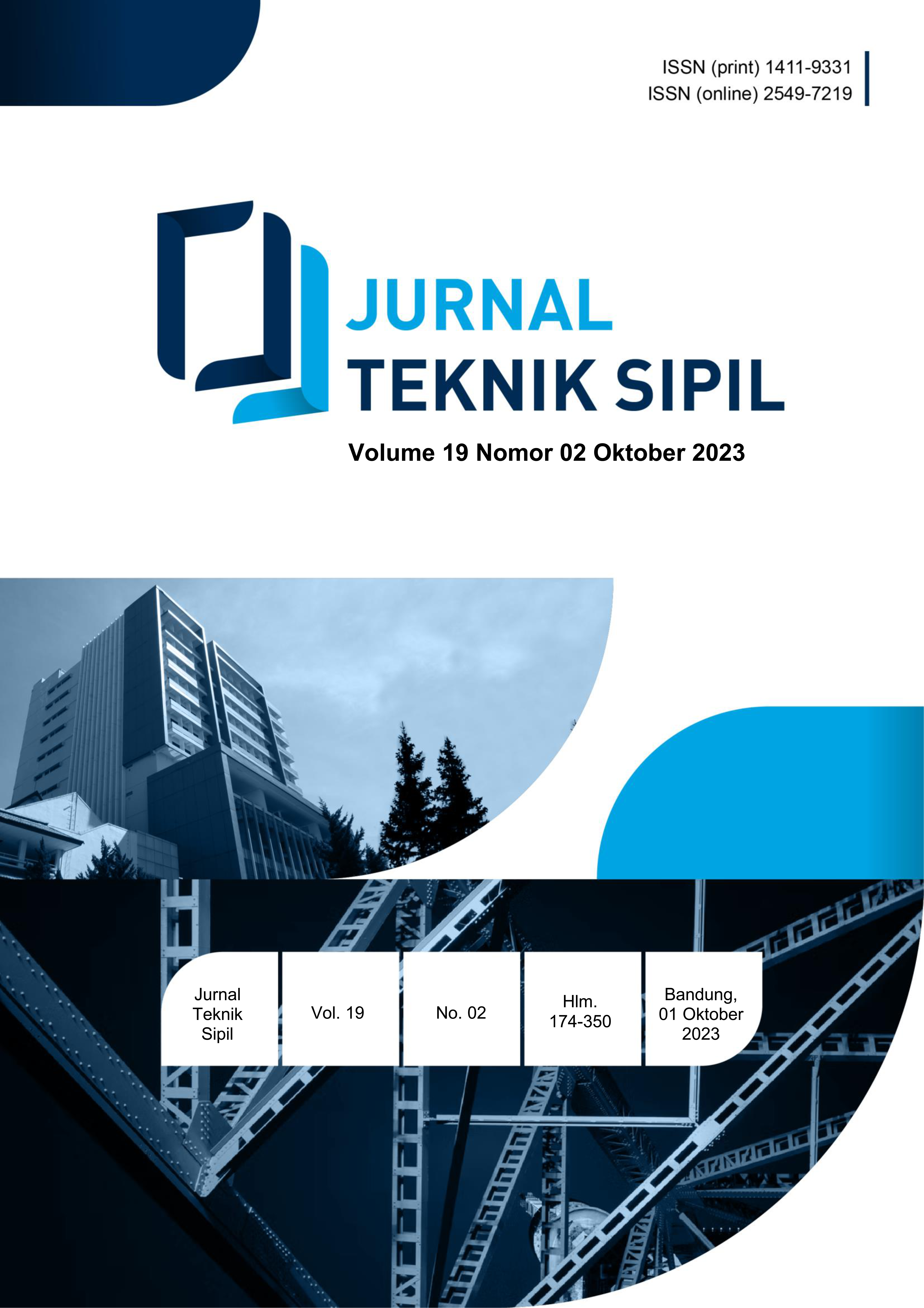Effect of Micro Lime on The Ambient Cured Sugarcane Bagasse Ash-Based Geopolymer Concrete
DOI:
https://doi.org/10.28932/jts.v19i2.7303Keywords:
Micro lime, geopolymer concrete, absorption, compressive strength, Green ConcreteAbstract
Geopolymer concrete has been the ideal replacement for Ordinary Portland cement concrete in producing green concrete. The binder in geopolymer concrete is a cementitious paste made from amorphous Aluminosilicate and activated by an Alkaline solution. The geopolymerization process is initiated at elevated temperatures. Thus, the curing requires elevated temperatures. This curing method limits the application of geopolymer concrete in the construction industry. In a geopolymer mix, the presence of Calcium ions allows the formation of Calcium Aluminate Silicate and Calcium Silicate Hydrate gels, allowing ambient temperature curing. Therefore, this study investigates the effect of micro lime on the Sugarcane Bagasse Ash-based geopolymer concrete. The micro lime was added to the geopolymer concrete in 1, 3, 5 and 7% by the Sugarcane Bagasse Ash weight. A mix design was based on a Densified Mix Design Algorithm. The tests carried out included compressive strength and water absorption. Ambient curing of the SCBA-based geopolymer concrete was achieved with 1% of the micro lime. The compressive strength increased with the increase of the micro lime, 10N/mm2 at 1%, to 18.25N/mm2 at 7% micro lime. The ambient temperature-cured geopolymer concrete at 3% micro lime had the lowest water absorption rate.Downloads
References
Abdalla, T. A., Koteng, D. O., Shitote, S. M., & Matallah, M. (2022). Mechanical and durability properties of concrete incorporating silica fume and a high volume of sugarcane bagasse ash. Results in Engineering, 100666. https://doi.org/10.1016/j.rineng.2022.100666
Abdullah, M. M. A. B., Meor Ahmad Tajudin, M. A. F., Mohd Tahir, M. F., Abdul Kadir, K., Sandu, A. V., Isa, N., & Corbu, O. C. (2017). Performance and Characterization of Geopolymer Concrete Reinforced with Short Steel Fiber. IOP Conference Series: Materials Science and Engineering, 209, 012038. https://doi.org/10.1088/1757-899X/209/1/012038
Adam, A. A., Amiri, N. H., Suarnita, I. W., & Rupang, N. (2016). The Effect of Lime Addition on the Setting Time and Strength of Ambient Cured Fly Ash Based Geopolymer Binder. MATEC Web of Conferences, 47, 01015. https://doi.org/10.1051/matecconf/20164701015
Adam, A., Maricar, S., & Ramadhan, B. (2019). The Effects of Water to Solid Ratio, Activator to Binder Ratio, and Lime Proportion on the Compressive Strength of Ambient-Cured Geopolymer Concrete. https://doi.org/10.22146/jcef.43878
Arasa, F. O., Onchiri, R., & Abiero-Gariy, Z. C. (2017). Effect of Sugarcane Bagasse Ash on the Engineering Properties of Blended Sandcrete Blocks. International Journal of Engineering Research & Technology, 6(12). https://doi.org/10.17577/IJERTV6IS120133
Davidovits, J. (2013). Geopolymer Cement a review 2013. 1–11.
Gagg, C. (2014). Cement and Concrete as an engineering material: An historic appraisal and case study analysis. Engineering Failure Analysis, 40. https://doi.org/10.1016/j.engfailanal.2014.02.004
Garcia-Lodeiro, I., Palomo, A., Fernández-Jiménez, A., & Macphee, D. E. (2011). Compatibility studies between N-A-S-H and C-A-S-H gels. Study in the ternary diagram Na2O–CaO–Al2O3–SiO2–H2O. Cement and Concrete Research, 41(9), 923–931. https://doi.org/10.1016/j.cemconres.2011.05.006
Karthiyaini, S. (2016). Physicochemical propertiesof alkali activated fly ash based geopolymer concrete: A review. International Journal of Earth Sciences and Engineering, 9, 2419–2426.
Koteng’, D. O. (n.d.). Concrete use for sustainable development. 19.
Naik, T. (2005). Sustainability of Cement and Concrete Industries. Proceedings of the International Conference on Achieving Sustainability in Construction. https://doi.org/10.1680/asic.34044.0017
Nawaz, M., Heitor, A., & Sivakumar, M. (2020). Geopolymers in construction—Recent developments. Construction and Building Materials, 260. https://doi.org/10.1016/j.conbuildmat.2020.120472
Parveen, Singhal, D., Junaid, M. T., Jindal, B. B., & Mehta, A. (2018). Mechanical and microstructural properties of fly ash based geopolymer concrete incorporating alccofine at ambient curing. Construction and Building Materials, 180, 298–307. https://doi.org/10.1016/j.conbuildmat.2018.05.286
Pavithra, P., Srinivasula Reddy, M., Dinakar, P., Hanumantha Rao, B., Satpathy, B. K., & Mohanty, A. N. (2016). A mix design procedure for geopolymer concrete with fly ash. Journal of Cleaner Production, 133, 117–125. https://doi.org/10.1016/j.jclepro.2016.05.041
Puertas, F., Palacios, M., Manzano, H., Dolado, J. S., Rico, A., & Rodríguez, J. (2011). A model for the C-A-S-H gel formed in alkali-activated slag cements. Journal of the European Ceramic Society, 31(12), 2043–2056. https://doi.org/10.1016/j.jeurceramsoc.2011.04.036
Temuujin, J., van Riessen, A., & Williams, R. (2009). Influence of calcium compounds on the mechanical properties of fly ash geopolymer pastes. Journal of Hazardous Materials, 167, 82–88. https://doi.org/10.1016/j.jhazmat.2008.12.121
Waqas, R. M., Butt, F., Zhu, X., Jiang, T., & Tufail, R. F. (2021). A Comprehensive Study on the Factors Affecting the Workability and Mechanical Properties of Ambient Cured Fly Ash and Slag Based Geopolymer Concrete. Applied Sciences, 11(18), Article 18. https://doi.org/10.3390/app11188722
Zhang, S. P., & Zong, L. (2014). Evaluation of Relationship between Water Absorption and Durability of Concrete Materials. Advances in Materials Science and Engineering, 2014, e650373. https://doi.org/10.1155/2014/650373
Downloads
Published
How to Cite
Issue
Section
License
Copyright (c) 2023 Keithy Kamau, Benard Omondi, Janet Oyaro

This work is licensed under a Creative Commons Attribution-NonCommercial 4.0 International License.
















